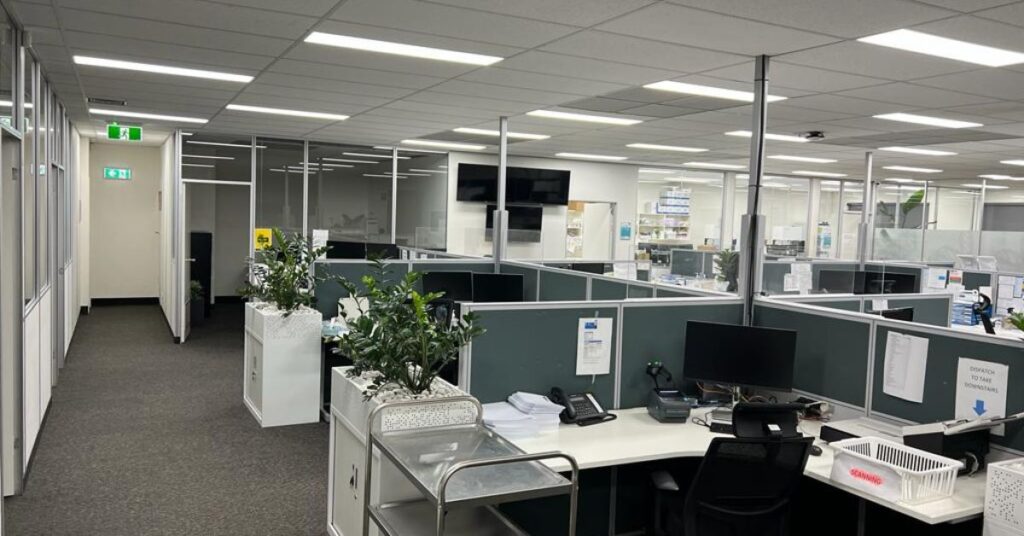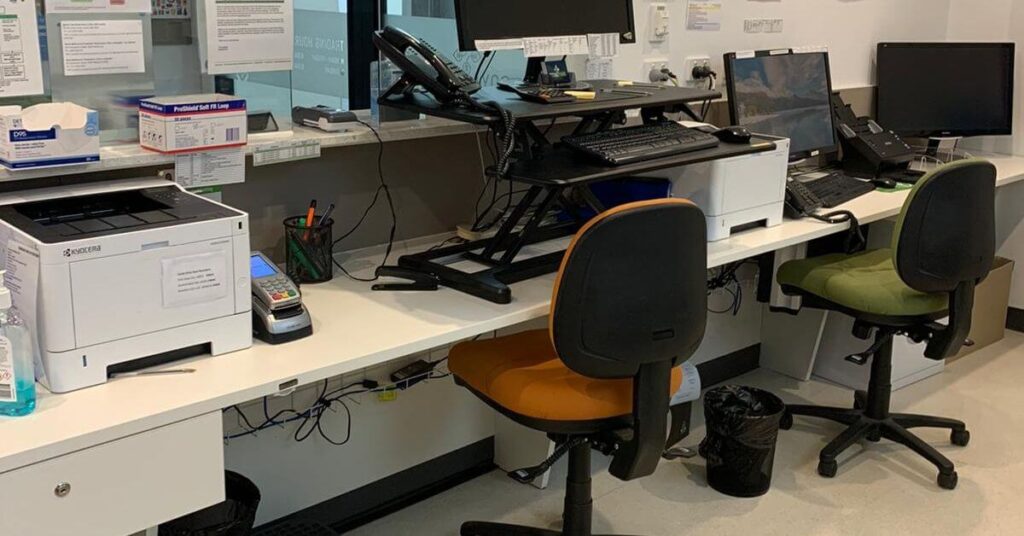How to Clean Fabric Chairs: The Easy Way

Have you noticed your fabric chairs looking worn out or with noticeable stains? If the answer is a resounding yes, you’re not alone! The everyday use of fabric chairs can cause wear and tear, and this can be taken as a call to refresh your office chairs. The good news is that cleaning fabric chairs is a breeze if you know what to use and how to use them. In this blog post, we will tackle the most frequently asked questions about fabric chairs and how to clean them yourself like an expert! Let’s dive in and find out how your workspaces can stay fresh and inviting.
Table of Contents
What are the different types of fabric chairs?
As an experienced commercial cleaner, I’ve encountered various fabric chairs with distinct features and maintenance requirements while office cleaning. Let’s explore the different types of upholstery fabric commonly used in chairs:
- Cotton: Throughout the years of my expertise, I’ve discovered that cotton upholstery fabric is a fantastic option for families and businesses. Even in places with heavy traffic, its durability is ensured by its resistance to fading and abrasion. I’ve seen cotton’s amazing capacity to breathe, which keeps it cool and stops it from getting too warm over time. One of its downsides is that although cotton may readily absorb colours to create colourful patterns, it can also readily absorb dyes from other materials or garments.
- Linen: Although lovely, linen requires a lot of upkeep, especially in places designated for adults, such as offices and workspaces. It is prone to creases and needs expert maintenance to stay immaculate. While linen may have certain drawbacks, including shrinking when washed, it is incredibly strong and simple to maintain. Another kind, referred to as performance linen, is more structured and keeps its shape effectively.
- Wool: Although wool is a natural and long-lasting upholstery material, it may not be the most comfortable choice due to its scratchy texture. Wool is susceptible to felting, a state where changes in temperature and friction cause the fibres to tighten and create felt. But I’ve also noticed that wool sometimes feels scratchy and could need extra care to avoid felting. If you blend wool with other types of fabric, it will be easier to clean and maintain.
- Fabrics made of synthetic materials: synthetic upholstery materials, including polyester, olefin, nylon, acrylic, and rayon, are made to be long-lasting and simple to clean. In actual use, I’ve discovered that polyester stands out for its softness, variety of colours and patterns, and simplicity of maintenance. On the other hand, I’ve noticed that rayon has a beautiful look similar to silk, but it needs cautious handling to prevent damage from liquid spills.
- Leather: Many expensive chairs and sofa sets are covered in leather, which is the height of luxury. What’s not to love about leather? I’ve realised, after cleaning so many upholstered chairs in my commercial cleaning career, that leather does age finely like wine and has that old-world yet classic charm. It’s important to note that the colours are limited, and it is highly vulnerable to scratches. Keep your furry friends away from your leather chairs!
What are the common causes of fabric chair stains?
Fabric chair stains often result from a range of factors, and I’ve had my fair share of encounters. Here are a few of these common causes:
- Food and Drink Stains: One of the most typical stains is caused by food. Grease, crumbs, and food spills may create marks very rapidly. I’ve seen many office chairs stained by coffee spills since employees normally have coffee at workstations. The key to these types of stains is to act quickly as soon as the liquid hits your chair.
- Marker and pen stains: Having cleaned so many offices over the years, I’ve seen chairs stained by ball pens, markers, and even colouring materials such as crayons and coloured pens. These stains are normally oil-based and could be very difficult to remove. This is the time you need to employ the help of a commercial cleaning company like ours at Core Cleaning Services.
What are the best cleaning products for fabric chairs?
Selecting the appropriate cleaning supplies is crucial for maintaining the immaculate appearance of your fabric chairs. I’ve worked as a seasoned professional office cleaner for many years, so I have first-hand knowledge of the many cleaning solutions designed for specific fabric types and stains. I’ll examine which cleaning solutions are most effective for fabric chairs in this article, providing knowledge based on my experience:
Dish Soap
Dish soap is designed to break down grease and grime, which is why it is so effective at removing food and drink stains. The detergent molecules in dish soap surround and trap grease and dirt particles, making it easy to wipe them away. It is a dependable option for getting rid of pesky grease and oil stains as well as persistent coffee and tea stains. Dish soap will easily remove wine or juice stains if you’re dealing with them. Moreover, dish soap will always come to the rescue when dealing with tough chocolate stains or the rare accident with ketchup and mustard. I like keeping a bottle of dish soap by my table for emergencies!
Vinegar
When it comes to removing pet stains and stubborn spots, vinegar is a trusted natural, and effective cleaning solution. Vinegar excels at dissolving organic stains while also dispelling foul odours because of its natural acidity. I personally love using vinegar at home because it’s cheap, highly accessible, and very safe for humans and animals.
Alcohol
Nope, we’re not referring to the alcohol you drink! Isopropyl alcohol, usually referred to as rubbing alcohol, is a solvent that works well to remove paint and ink stains. It is a typical home item that is reasonably priced and can be easily bought at your neighbourhood mart or Chemist. Rubbing alcohol can dissolve ink or paint particles, making it a quick and easy solution for marker stains. Applying a tiny amount of rubbing alcohol to a clean cloth and blotting the stain will work to remove paint and pen stains.
Commercial Upholstery Cleaners
The cleaning requirements of fabric chairs and other upholstered furniture are catered for by commercial upholstery cleaners, which are expertly and specifically made. These professional-grade cleaners are more powerful than their domestic alternatives and can easily remove a wide variety of stains, even those that are deeply ingrained or more challenging. Commercial upholstery cleaners frequently contain a wide variety of ingredients in their composition, such as surfactants, solvents, and enzymes. Surfactants loosen and dislodge dirt, while enzymes help break down organic stains.
How often should I clean my fabric chairs?
Choosing the right cleaning schedule for your fabric chairs is a wise move that will ensure their durability and maintain their aesthetic appeal. It’s normally advised to hire expert office cleaning services for sofas and other household upholstery every 6 to 12 months. Your prized fabric chairs will remain fresh, spotless, and durable thanks to a regular office cleaning contract. Removing stains from the upholstery can help stop or delay the degradation of your fabric’s fibres.
How to Clean Fabric Chairs: A Step-by-Step Guide
Whether they are in your dining room, workplace, or comfortable living room, fabric chairs frequently take the brunt of daily life and unwittingly become witnesses to spills, stains, and dust. Regular office chair cleaning not only keeps them looking good but also makes them last longer. Here is a step-by-step guide infused with personal experience and knowledge to make sure your fabric chairs stay the ideal seating partners all year long.
1 Regular Vacuuming
Regular Vacuuming: Include regular vacuuming in your cleaning routine to start rejuvenating your fabric chairs or upholstered chairs. Explore the cracks where misplaced coins, stray food crumbs, and dust make themselves at home. This is why it’s important to have a strong, heavy-duty, and durable vacuum cleaner that has different attachments to help you remove surface dirt and dust from hard-to-reach areas. When using a vacuum cleaner, choose the right attachment and carefully glide the attachment across the surface and inside the cracks and crevices. This little procedure, carried out at least once a week, keeps your chairs free of dust, stopping them from getting into the fabric and increasing the life of the chair.
2 Check if your fabric chairs have labels or care directions
Review the care directions for the upholstery before using your cleaning product. This crucial stage aids in your selection of the best cleaning supplies and methods that won’t make the problem worse. Knowing the kind of upholstery you have—water-safe or solvent-only, for example—will help you choose the proper cleaning strategy.
3 Spot clean visible stains
Accidents are inevitable, wherever you are. These accidents can leave stains that can ruin the aesthetic appeal and comfort of your fabric chair. When it comes to spills, time is of the essence. Once the stain gets absorbed into the fabric, be quick to act and get a white paper towel to blot the area to avoid further spread. Do not use circular motions when spot cleaning because the motion tends to spread the stain and embed it deeper into the fabric. I’ve had the experience of spilling wine onto my favourite white linen sofa. In my panic, I picked up any cloth I could find and vigorously rubbed the stain like there was no tomorrow. The end result? A larger and harder-to-remove wine stain! Another tip is to use vinegar when water doesn’t remove the stain. Use equal parts water and vinegar, and use a microfibre cloth to remove the stain.
4 Make a stain-removing solution
If you don’t want to buy commercial upholstery cleaning solutions, you can create your own cleaning solution at home! For water-based stains, you can mix a cup of lukewarm water with one-fourth cup of dishwashing liquid. Mix until you create suds. Dip a soft sponge into the solution and gently scrub the stained areas. Rinse the sponge and repeat. A tip from our commercial cleaning experts is to not let the stained area dry under direct sunlight because it can further damage the fabric and make the stain more difficult to remove.
5 Remove foul-smelling odours
Stains aren’t the only thing you should be worried about when it comes to your upholstered chairs. You should also worry about the smell! Stains are often accompanied by nasty odours that can instantly turn off anyone who has to sit on a filthy chair. The good thing is that you can remove bad smells by sprinkling bicarbonate of soda on the stained area overnight and vacuuming it off the next day.
6 Dry
Once you’ve cleaned the areas that needed attention, it’s now time to dry your upholstered office chairs. The most important thing to remember is to avoid sunlight when drying. Air-dry your furniture in a shady area with lots of air circulation.
FAQ
The cost of cleaning fabric chairs or upholstered furniture varies per cleaning company. Most commercial cleaning or office cleaning companies charge for their chair cleaning services per piece of furniture. For example, if you have a three-piece fabric sofa set (with each chair costing around $35), you’re going to be charged approximately $105 for the entire set. The cost of cleaning upholstered furniture will also vary depending on the type of chair and its size.
For many of us who own homes and work in offices, upholstered furniture like office chairs and sofa sets represent one of our largest investments. We might as well accept the obligation of keeping the material in good condition so that it lasts a very long time. Here are some helpful tips for cleaning fabric chairs:
- If it’s a fresh spill, don’t scrub. Blot.
- Use the right vacuum attachment
- Don’t use fabric softeners
- Change your cushions around
- Take caution when using fabric protectors
- Use the steam cleaning method to get rid of tough stains
Yes, definitely! Hiring office cleaning specialists like us at Core Cleaning Services will save you time, money, and energy. We are fully equipped with the right equipment, tools, knowledge, and experience to get rid of stubborn stains and dirt from your office chairs.


